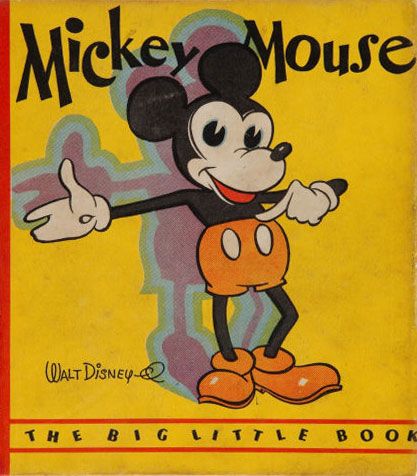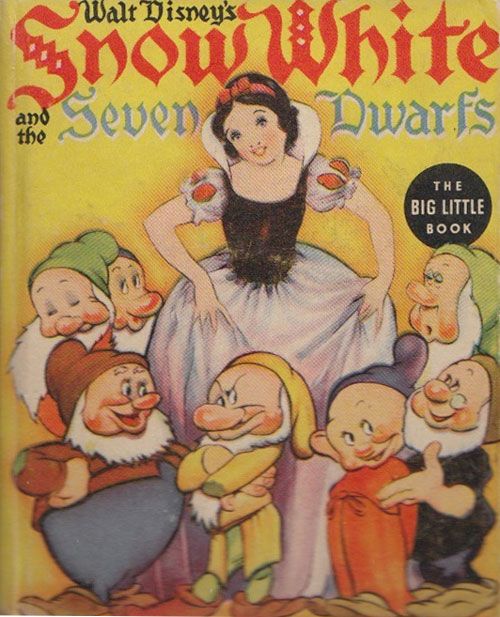On Saturday, August 25, I attended a presentation at the Walt Disney Family Museum titled “Walt Disney’s Big Little Books,” hosted by renowned Disney author and historian J.B. Kaufman. J.B. is responsible for such wonderful books as: Walt in Wonderland: The Silent Films of Walt Disney, South of the Border With Disney (one of my favorites), and the soon-to-be-released The Fairest One of All: The Making of Walt Disney's Snow White and the Seven Dwarfs. After a nice intro by Michael Labrie, Director of Collections at The Walt Disney Family Museum, J.B. took the podium to provide some terrific history on all things Big Little Books.
The little books with the big name got their start in 1932, thanks to the Whitman Publishing Company. Also referred to as “Better Little Books,” the first official title was The Adventures of Dick Tracy. The books were roughly 3.5 by 4.5 inches in size, hundreds of pages long, and printed on newsprint. They sold for 10 cents, and were geared towards an audience of young adventurers, featuring such characters as Tarzan, Terry and the Pirates, and Flash Gordon.
Disney’s first foray into Big Little Books came in 1933, and bore the simple title of Mickey Mouse. It was drawn by Disney Legend Floyd Gottfredson, who was actually given a fair amount of autonomy on the project. Gottfredson was a fan of adventure stories himself, thus the plot of Mickey Mouse entailing Minnie Mouse being kidnapped by gypsies. In a later story, Mickey sailed to Treasure Island. Big Little Books were often adapted from existing stories or films.
 |
| Mickey, is that you? |
To contrast an adaptation, J.B. showed us the Mickey Mouse short, The Mail Pilot. On one of his mail runs, Mickey encounters a sky bandit (and Mickey villain staple) by the name of Pete, who uses a machine gun to conquer his airborne prey. Like always, Pete underestimates Mickey’s ingenuity and sheer force of will, as an unarmed Mickey manages to defeat his perpetual rival. The Mail Pilot is a clever little short, and one of J.B.’s favorites. The Big Little Book version, however, is somewhat different. In it, Mickey is equipped with his own machine gun, because pilots and their planes have been disappearing at an alarming rate. It turns out Pete is up to his old tricks, and is kidnapping pilots mid-flight from a dirigible, which contains its own small town. Spoiler Alert: Mickey ends up defeating Pete in this one as well.
The Mail Pilot Big Little Book was adapted from the comic strip version, which was adapted from the short. Since they had a significantly smaller amount of width in which to work, images had to be cropped. This of course altered the scene’s scope, however thanks to clever positioning, they made it work. Another space-saving technique saw the dialogue shifting from dialogue bubbles in the comic strip to having text on the left page and images on the right page in the Big Little Books.
We were then shown the “entertainment scene” from the beloved film, Snow White and the Seven Dwarfs. This is the scene in which they all danced, and some sang, in the dwarfs’ cottage. The scene in the film ran roughly seven minutes in length. When artists had to draw that scene for the comics, it had been adapted to fit in one panel! When it came time for the Big Little Book version, more changes followed. Some of the art from the comics appeared to have been traced, only flipped horizontally. Another relatively large modification made was, Dopey spoke! “Let’s dance” was one of his lines from the entertainment scene. When the dwarfs first discover someone (or something) is in their room, and Dopey is elected to investigate, he verbalizes his findings. “It’s asleep,” he reported.
What would the Snow White story be without the Queen? Officially referred to as “The Evil Queen” by Disney, she was actually given a name for the printed stories, like the comics and the Big Little Book. Queen Grimhilde was her name, and she was just as menacing in print. In the Big Little Book, she kidnapped the prince and locked him in the dungeon. Another variation came after the Huntsman returned from his mission and advised the Queen that Snow White was dead. The Queen ended up shattering the Magic Mirror, and the Magic Mirror laughed at her. Creepy, but doesn’t occur in the film.
J.B. theorized that the Big Little Book writers must have either been story men on the animated features they were adapting, or had access to more material than just the finished product. For example, one scene in the Big Little Book featured the Old Hag in her dungeon, stirring the liquid in her cauldron and chanting, “Boil, cauldron, boil.” Now this scene actually took place in the film, however, it was cut just prior to the premiere.
The end of the Snow White Big Little Book had her saying goodbye to her little friends. “They were sorry to see their friend go,” it said of the dwarves, “But they were glad to see her happy.” “I’ll come back and visit you every spring,” Snow White told them. Grumpy merely replied with, “Bah, women. They just come and go.” As he uttered that, however, he was secretly looking forward to next spring.
After the presentation, J.B. stuck around to answer a few questions from the audience. As always, as the presenter, I bugged him for a quick photo.
 |
| Fresh from a softball game, and J.B. lookin' sharp |
After that, one of the audience members approached J.B. to show him that he had a Big Little Book of his own. That audience member was Mr. Tim Jinks, frequent visitor to the Walt Disney Family Museum, and friend of The Disney Project. With his wife Jane acting as photographer, I bugged him for a photo as well!



Just found this post. Very nice. Glad you got to meet J.B. in person. Thanks for sharing.
ReplyDelete